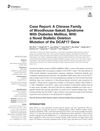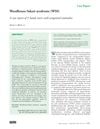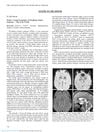Novel Splicing-Site Mutation in DCAF17 Gene Causing Woodhouse-Sakati Syndrome in a Large Consanguineous Family
December 2021
in “
Journal of clinical laboratory analysis
”
TLDR A new mutation in the DCAF17 gene was found to cause Woodhouse-Sakati syndrome in a large family.
The study investigated Woodhouse-Sakati syndrome (WSS), a rare disorder causing neurological issues, endocrine complications, and abnormal ectodermal structures like hair loss, in a large consanguineous family with five affected individuals. The researchers identified a novel splicing-site deletion variant in the DCAF17 gene, which is believed to cause WSS. This gene produces two nucleolar proteins thought to be responsible for the neurosensory, endocrine, and cutaneous phenotypic expressions seen in WSS, including hair loss that begins in childhood and often results in alopecia totalis during adulthood. This is the first reported splicing-site deletion mutation in the DCAF17 gene. The study highlights the importance of genetic testing in diagnosing WSS, especially in young patients where symptoms have not fully developed.


